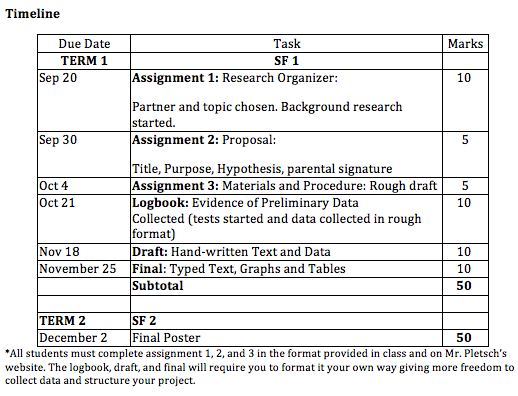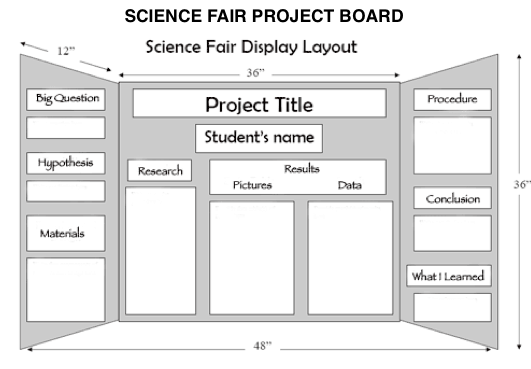New Note: Are you working with people? Even just a survey? You have to complete an ethics form before you start gathering data. See the flow chart below – I can help you with the paperwork!
SCIENCE FAIR ASSIGNMENT OUTLINE – TERM 1 (50 Marks)
The science fair project is split into two elements over two terms: SF 1 is in Term 1 and SF 2 is in Term 2. Combined, they are worth 100 Marks. This will be in the projects bin in terms of marking and grading, and therefore it will influence your term 1 and 2 grade greatly!

Science Fair Information and tips:
It’s that time of the year again, science fair! You may work with a partner or alone – yes that means you can work with someone from another class! Below is some information about each section required for a strong science fair project:
Example layout:

The following sections should be on your display:
- Title
The title is the first contact you have with the reader; many people will read the title but only a few will read the entire report. While the title should not be wordy, it should adequately describe the contents of the report in the most concise language possible.
2. Hypothesis
Your educated guess to the question discussed in the title. Use the “If…(Independent variable)…then… (dependent variable)” format.
3. Background Research
Very few ideas come appear out of thin air. Most science fair projects are built on previous science experiments and understanding. In this section you need to outline the science that your work is based on, referencing any experiments you are building on, or scientific research that relates to your topic. The background research should contain no more than 250 words.
4. Materials
This section is a simple list of all materials you used in your experiment. You should be specific as possible so that if someone were to repeat EXACTLY your experiment they could
5. Procedure
This section is a clear outline of what you did in your experiment. Remember that any experiment should be repeatable, which means another scientist reading your instructions can do EXACTLY what you have done. For this to be possible you must be specific and exact. For example, if you used water on a plant in your experiment, what quantity of water did you use exactly? How often did you water the plant? What temperature of water did you use?
6. Observations and data
This section is where you put both the charts and graphs that your raw data produces. You can present your data in many ways; from table graphs to photos, and many more. Regardless of how you present your results you must be clear and concise. What your results are should be readable and easily understood, representing your results in the most straight forward and eye-catching manner.
7. Discussion
This section is where you analyze your results. You are describing not only what happened, but what you think it means. If you were a lawyer in a court case this would be where you explain each piece of evidence to the jury, making your case. It is important to be honest; if your data disproves your hypothesis that is OK. You can get full marks if your hypothesis is wrong and you admit it, you will lose marks if you try to force the data to match what you wanted to happen
Do not simply re-state your results, you are meant to be analyzing them.
8. Conclusions
The conclusion is intended to be very short and should summarize your finding and link to your hypothesis. Did your experiment support your hypothesis? Or do you reject it? Any future studies you think should be done on this topic?
Types of Projects:
- Experiment: This is traditionally the most common type of science fair project. A winning exhibit of this type should involve an original scientific experiment to test a specific hypothesis in which the young scientist recognizes and controls all significant competing variables and demonstrates excellent collection, analysis, and presentation of data. The judge should also realize that it is not regarded as essential that any significant positive findings result from the project. It must be recognized that it is the design rather than the results that are most important.
Ex: The effects of different liquids on plant growth, The effects of surface area of chemical reactions (think about using different size calcium chloride pieces in the baggie chem experiment), The microscopic biodiversity of various ecosystems around Vancouver (collect samples, count microorganisms), the effects of light on bacteria growth, is the five second rule real, the effects of different types of sugar on crystal formation (making rock candy with different types of sugar), the effects of salt on freezing point of water, speed of biodegradability of 3D printer material, the effects of caffeine on flatworm nervous systems, determining whether or not a cereal contains the amount of iron per serving listed on the box, are natural sponges more effective at absorption over synthetic sponges.
- Innovation: A project of this type would involve the development and evaluation of new (or significant improvements to existing) devices, models, techniques or approaches in fields such as technology, engineering, or computers (both software and hardware). A winning project should integrate several technologies, inventions, or designs and construct an original innovative technological system that will have commercial application and/or human benefit. It must demonstrate how the innovation was designed or developed on the basis of a sound understanding of the scientific, engineering, or technological principles involved.
Ex: Creating a game using python, code breaking using python, developing a method to remove micro plastics from the ocean, make a heart rate monitor, Minecraft as an education or study tool (editing and creating a Mine craft world to teach a concept to students).
- Study: This type of project involves the collection and analysis of data from other sources to reveal evidence of a fact, situation, or pattern of scientific interest. This could include a study of cause and effect relationships or theoretical investigations of scientific data. A winning exhibit in this area must be able to demonstrate that the methods used to obtain the original data involved sound scientific techniques and controls, and demonstrate insightful analysis.
Ex. The rate of decline in sharks and the effects on the ecosystem, organic vs. GMO foods impact on the environment, etc. These are your research projects – but be aware you need to find data from real scientists and their studies and chart and discuss it!
Comments by shaun pletsch